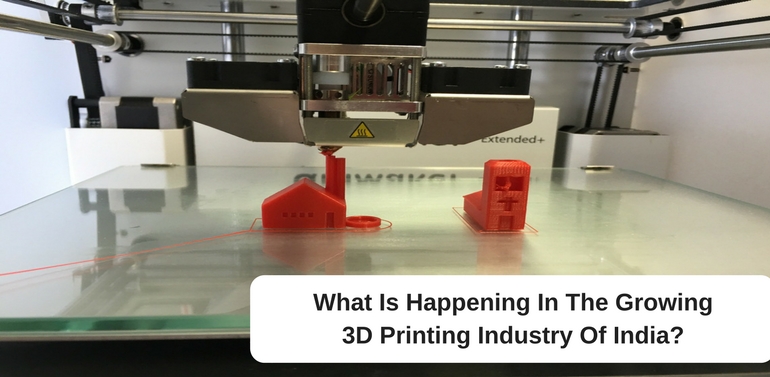Additive manufacturing (AM) or 3D printing, as commonly recognized, is taking the world by storm. From the applications in rapid tooling, affordable prototyping and toy making, very soon it is going to be adopted in mass manufacturing processes. China, being the factory of the world, is also adopting and experimenting with new 3D printing technologies. But what is the situation in India? Are we on the same page with leading countries? Where are the scopes of AM technologies in India? We’ll discuss all these and more in this article. Stay with us.
What is additive manufacturing?
Traditionally, manufacturing involves cutting away or subtracting materials from a block of metal or other substances by milling, drilling, boring or other machine operations manually or by mechanized and computerized tools. Other than machining, injection moulding is also extensively used in manufacturing metal and non-metal objects. Additive manufacturing is completely different from both the types.
In this process, a 3-dimensional object is manufactured by adding and solidifying materials in layers. The whole process is controlled by computer program on the basis of 3D design file fed into the system. Such manufacturing process is called additive because materials are added in making the final product instead of cutting away. Multiple 3D printing technologies are emerging today starting from the basic most FDM or fused deposit modelling to more advanced stereolithography or STL. New technologies are faster, more efficient and capable of printing with materials like, ABS plastic, nylon, epoxy resin, titanium, gold, silver, aluminium, steel and many more.
Beginning of 3D printing industry in India
Commercial 3D printing industry mostly started around 2012 holding the hands of a few private start-up initiatives. Some of them built their 3D printers using freeware design and software available on internet. These were primarily based on FDM technology as copyright restriction on this technology was lifted in 2009 and was highly popular in DIY (do it yourself) circuit. Different business models also emerged like,
- offering printing as service,
- printer manufacturing,
- printer resale
- conducting 3D printing training programs in schools, colleges and universities.
Some of these pioneers are Brahma3, 3Dify, 3D Labs India, LBD Makers and ProtoPrint.
Despite late start, 3D printing industry as a whole in India is slowly catching up with global trend. With increasing popularity, demand is also improving, helping the industry to survive the nascent stage. Along with traditional prototyping and rapid tooling requirements in industries, consumer level interest is also growing up. Today too many 3D printing businesses are working in consumer space manufacturing items like,
- Jewellery
- Desk décor
- Small figurines
- Wall décor
Challenges before Indian 3D printing industry
First of all, the biggest challenge is the high cost of commercially viable imported printers and printing stationaries. It makes 3D printing a lot more expensive in India compared to global standards. Freely available FDM technology based printers, affordable and more common in India, are slow, restrictive in terms of materials usage and not capable of producing high quality.
Second, this is a highly capital intensive business; and in absence of steady demand and reliable business model it is becoming difficult to recover the cost of capital for too many.
Third, lack of strong indigenous design skill is also hampering growth of 3D printing in India. Companies are often depending on freely available designs instead of offering fresh concepts.
Fourth, for restriction in term of printing size often many products cannot be manufactured at a one go and require further expense on finishing. This often increases cost for small batch manufacturing.
Fifth, unlike China, India is not a manufacturing- centred economy. Prototyping is still considered as an expense and not as an investment, even by engineering and designing firms. This attitude is also restricting growth in demand.
The silver lining in the horizon
Despite all the challenges and limitations discussed, 3D printing industry is destined to mature and grow in India. As per some market estimates, this industry will be growing at a CAGR of 20% till 2021. Some of the strong fundamental reasons are explained here.
- Demand for customized products – in an economy of billion plus population demand for manufacturing bespoke products in small batches is quite strong in India. Newly emerging AM technologies can be particularly effective for such applications.
- Frugal technology – India is popular for its innovative frugal technology solutions and is a country of makers. In that perspective 3D printing has lot of future in the country.
- Strong consumer oriented demand – this segment is already peaking up especially for artistic and other home décor items.
- Government support – since 2015, government of India (GOI) has come forward in support of 3D printing industry in India. It is also a strong component of make in India initiative. Programs are being taken up to popularize and train public school students in 3D printing technology. Also, GOI is sponsoring investments in AM-based rapid prototyping machineries under Atal Incubation Mission for training and promoting domestic entrepreneurship.
- New opportunities – 3D printing industry in India is also going to benefit from recent government-support in aerospace & military industry. Medical application is another area where India offers immense opportunity in coming days for 3D printing entrepreneurs.
Finally…
3D printing industry is going to bring in a sea change in manufacturing sector, in India as well as abroad. Technological advancements are also happening in fast pace. Surviving and growing in such an environment require strong understanding of technology and flexibility in terms of business model. A lot of changes in terms of demand and supply will emerge in coming days. Many of these changes are difficult to guess at this moment. It will be important for 3D printing entrepreneurs to keep a track of the situation and invest in suitable avenues.

